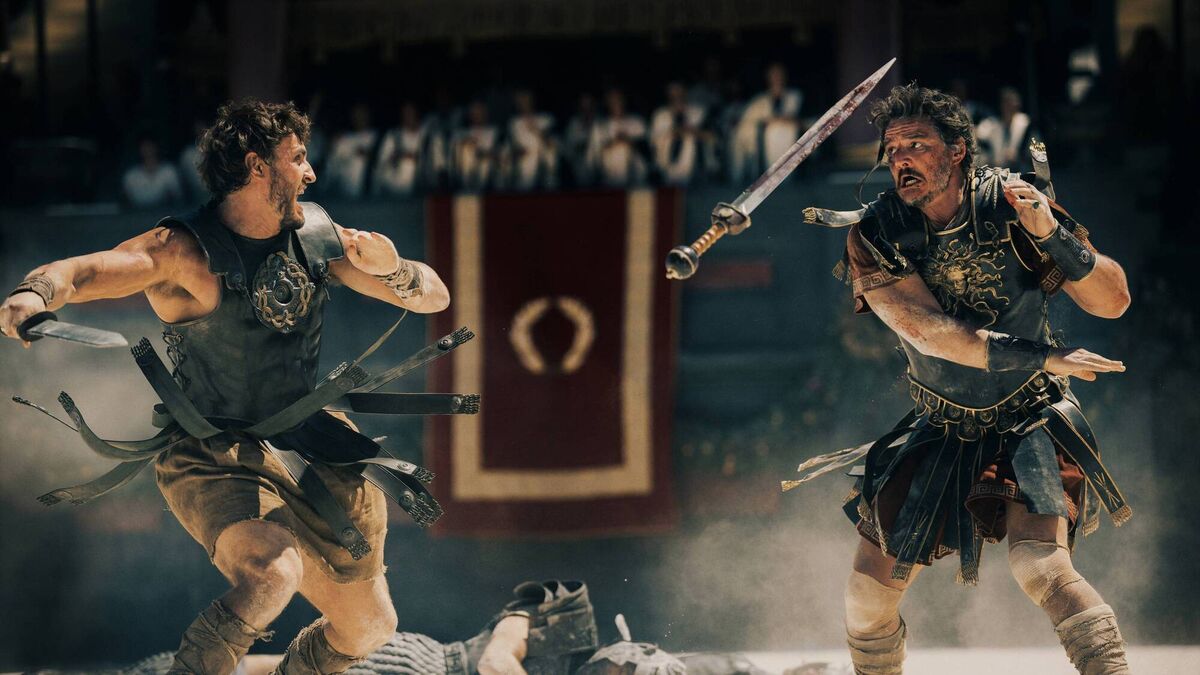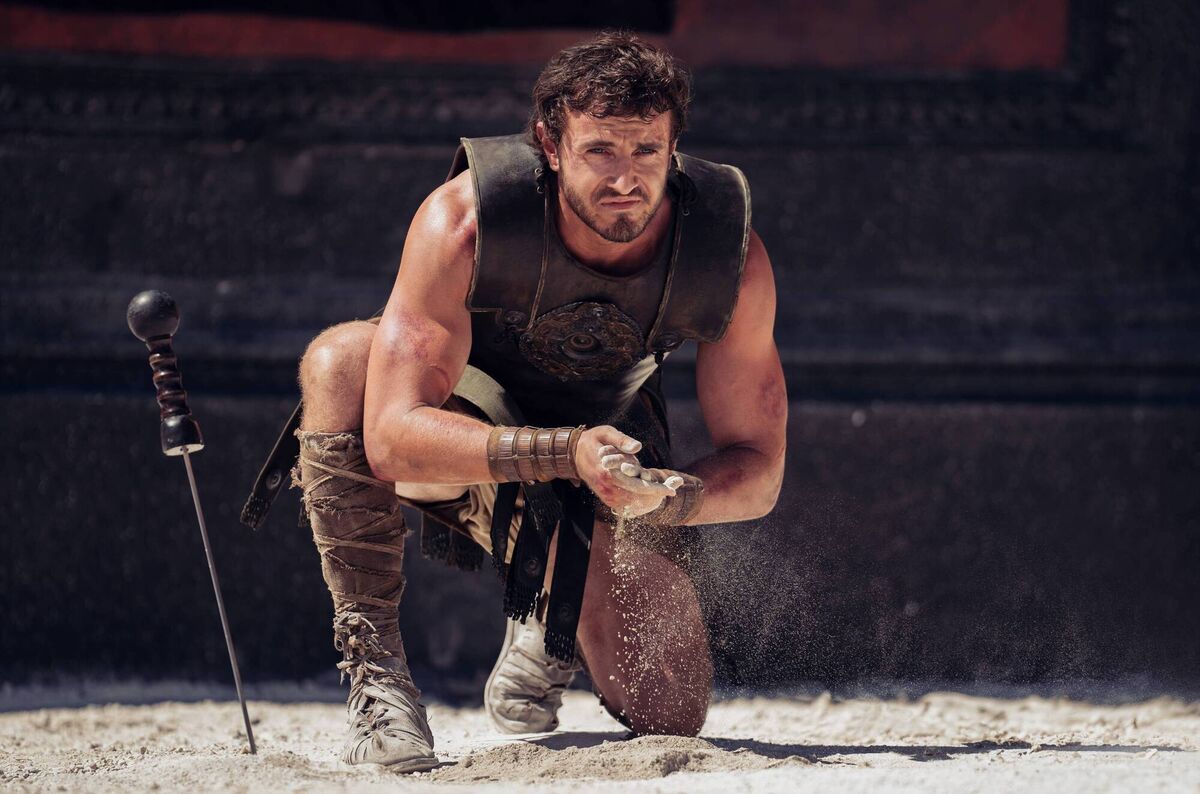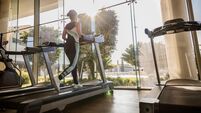For those about to sweat: How Paul Mescal got fighting fit for Gladiator II

Kildare man Paul Mescal looking ready for battle in the trailer for 'Gladiator II'. Image via YouTube
Ridley Scott's is the blockbuster film event of the season, but the excitement about the long-awaited sequel to the legendary director’s 2000 Oscar-winning epic centres firmly on the performance — and appearance — of Paul Mescal.
Admitting he had no previous experience of bodybuilding or working out, the 28-year-old Irish actor transformed himself for the lead role of Lucius in the film, reportedly adding over 8kg of solid muscle to his 180cm frame, earning the nickname ‘Brick Wall Paul’ from co-star Pedro Pascal.
While he may have played down the efforts required to achieve Gladiator status — “I ate a lot of chicken and lifted heavy things,” Mescal told Graham Norton in a recent interview — his head-turning physique represents a shift in the ideal of how a Hollywood male body should look and move.
A-listers have moved on from the era of muscle bulk when Sylvester Stallone and Arnie Schwarzenegger flexed their enormous biceps to the relatively lean and slimline appearance of Jacob Batalan, who reportedly shed 45kg on a plant-based diet for his role in a 2021 Spiderman movie.
In this latest role, Mescal has taken a huge stride toward popularising a body type that is functionally as well as aesthetically impressive.
As he told earlier this year, preparing to play Lucius left him feeling and looking different.
“Muscles start to grow, and that can be deemed aesthetic in certain capacities, but there is something about feeling strong in your body that elicits just a different feeling,” he said. “You carry yourself differently.”
Studies have shown that strength training is among the most important step we can take to preserve our health and appearance as we age.
By our mid-30s, most of us are losing muscle mass at a rate of about 5% a decade. Lower levels of lean muscle tissue mean that the body’s metabolic rate — its ability to burn calories — slows, making obesity and related problems more risky.
Since muscle tissue helps to keep bones strong, our skeletal health suffers, raising the risk of osteoporosis as we age.
“Improving muscle health and strength is extraordinarily good for us,” said Irish trainer Zana Morris.
“Lifting weights or resistance training improves our muscles, bones, mood, and mind, and is an excellent fat blaster.”
Lifting weights just twice a week, for about an hour, has been shown to boost metabolism and aid fat loss.
It can help to cut the risk of heart disease and strokes by 40% to 70%.
Building muscle strength is also a route to a reduced risk of type 2 diabetes.
Experts say there are benefits and pitfalls to building a gladiator-style body and that most of us do not need ultra-processed supplements and shakes to achieve healthier muscles and a stronger physique.
For a paper published in the journal Physiological Reviews last year, sports physiologists from Dublin City University looked at how our muscles adapt to exercise training.
Brendan Egan, associate professor of sport and exercise physiology and co-author of the paper, said that physical exertion, such as weight training, triggers muscle cells to produce proteins that ultimately help to make our bodies stronger but that any type of exercise benefits muscle health.
Personal trainer Dalton Wong, who has worked with male celebrities for and , says you can start with resistance bands before progressing to weights, which should gradually become heavier over time, and aim for three sessions a week, preferably on non-consecutive days.
“With resistance training, you are helping to ramp up muscle-protein synthesis and build new muscle tissue by using your body’s amino acid reserves for each muscle contraction,” says Wong.
“But regular weights also help your body’s skeletal muscle to remove carbs from the bloodstream, protecting against conditions such as type 2 diabetes.”

In the interview, Mescal described how his training centred on ‘fight choreography’ and not just repetitive lifting of heavy weights to sculpt his gladiator shape.
“Sometimes, one could, in striving for that perfect look, end up looking more like an underwear model than a warrior,” said Mescal.
Instead, it’s likely he incorporated numerous compound moves that engage multiple body parts in one exercise, such as dips, squats, and lunges, battle ropes [waving very thick, weighted ropes], and dynamic jumps and weighted medicine ball throws.
“Training in a more dynamic way using as many muscles as possible will help you to achieve a more athletic and lean physique,” said Wong.
“Add some balance work using Bosu balls and leg squats, which are also helpful for muscle development.”
To gain muscle at any age, you need to increase the amount of protein in your diet without sacrificing healthy fats and carbs.
This is particularly important from mid-life onward when we are fighting a battle against sarcopenia, the natural process that sees us lose up to 1kg of muscle a year.
In his review, Egan outlined how protein consumption is important for health even if you don’t want to look like Mescal in his recent role.
“We have pathways of protein degradation or breakdown that are switched on in response to exercise and we need to consume protein to support these,” said Egan.
Good-quality proteins are easily obtainable in the diet — think eggs, yoghurt, nuts, chicken, and milk.
Current guidelines by health chiefs suggest adults need about 0.8g-1g of protein daily per kilogram of body weight, which equates to 50g-63g, or two to three palm-sized portions, for an adult weighing 63kg.
“Research from McMaster University has shown that intakes of up to 1.6g per kg for an active person are needed to support muscle health from middle age onwards,” says Wong.
“To give you an idea of what this means, a skinless chicken breast contains 54g, a 145g can of tuna 40g, two eggs 14g, a 250g steak 62g, and beans, peas, and lentils anything from 5g to 8g per 100g.”

Alcohol is not only high in calories but can have the effect of reducing testosterone, a muscle-building hormone, in men.
Other scourges for the mid-life body are sugary and processed foods that send insulin levels soaring, with sugar disrupting the way we break down and store fat.
“All of these foods provide calories we don’t necessarily need and can make achieving a leaner and muscular body much harder,” says Wong.
“Get a sweetness shot from the naturally occurring sugars in fruit and vegetables.”
At night, when we sleep, our bodies release growth hormones and extra protein molecules that boost the immune system and help the body to protect itself from the onslaught of stress and infections.
“Sleep is also when the hormones that affect your appetite are regulated, and it is vital to get seven to eight hours to aid recovery from workouts as we get older,” says Wong.
Active recovery — walking, stretching, foam rolling — will also help to speed up the restorative process so that you are ready to train again when required.
Some studies have shown that saunas, cryotherapy, and cold baths reduce the perception of muscle soreness and speed up recovery so that you are ready to go again.

Celebrating 25 years of health and wellbeing










